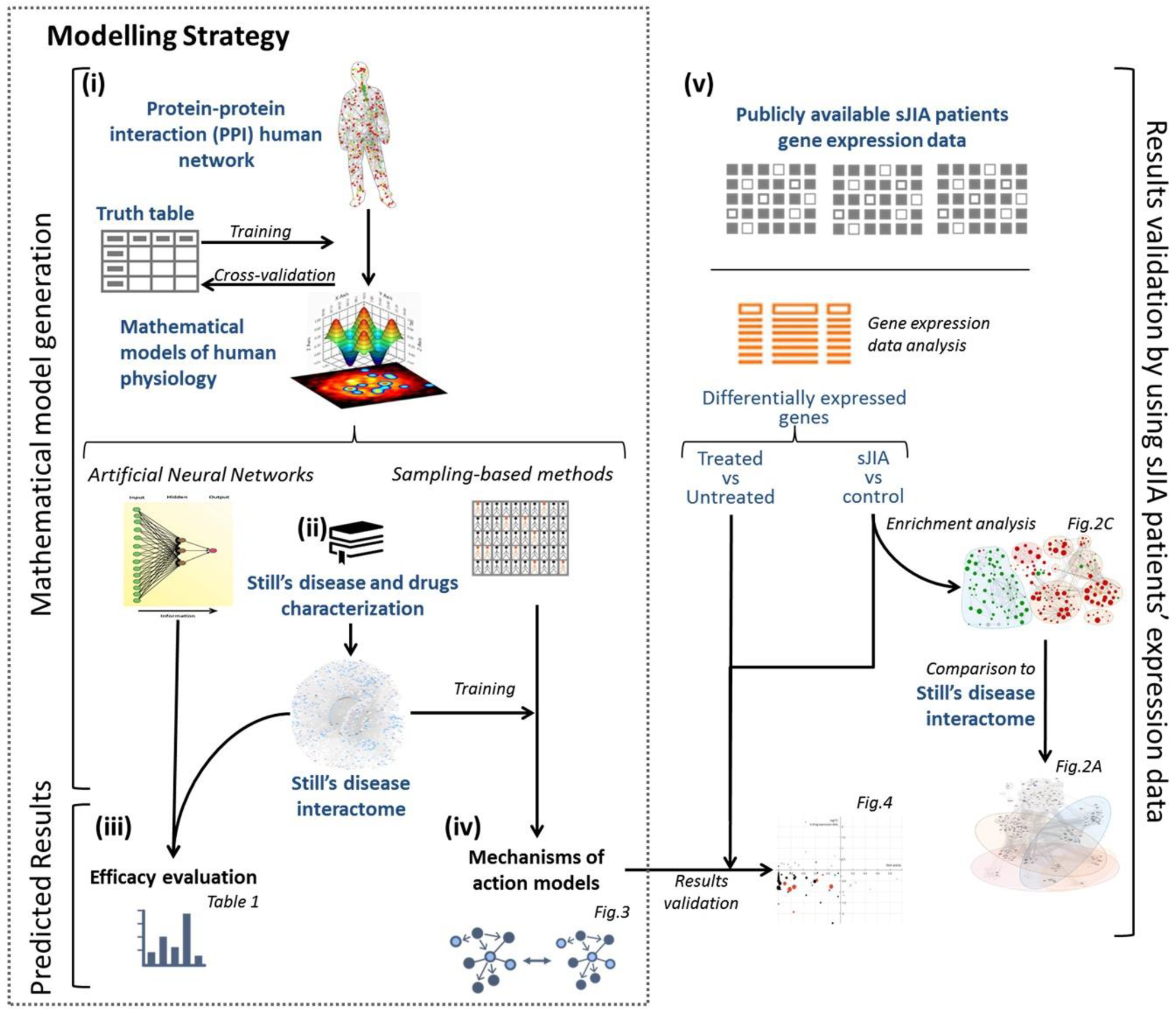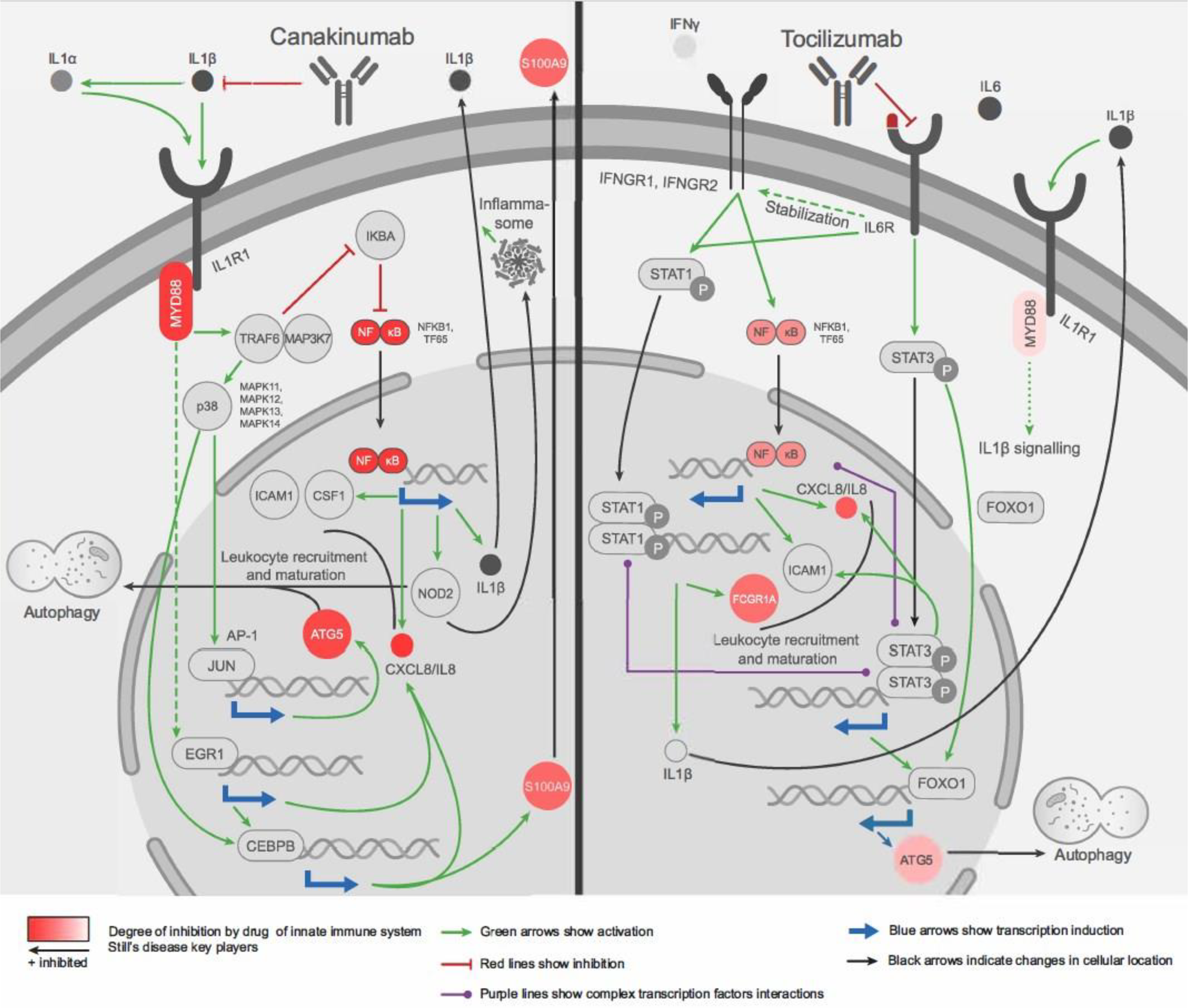

Background: Systemic Juvenile Idiopathic Arthritis (sJIA) and Adult Onset Still’s Disease (AOSD) are manifestations of an autoinflammatory disorder with complex pathophysiology and significant morbidity, together also termed Still’s disease.
Objectives: To investigate the optimal treat-to-target strategy for Still’s disease by in silico models based on systems biology.
Methods: Molecular characteristics of Still’s disease and data on biological inhibitors of interleukin (IL)-1 (anakinra, canakinumab), IL-6 (tocilizumab, sarilumab), glucocorticoids as well as conventional disease-modifying anti-rheumatic drugs (DMARDs, methotrexate) were used to construct in silico mechanisms of action (MoA) models by means of Therapeutic Performance Mapping System technology (TPMS). TPMS combines artificial neuronal networks (ANN), sampling-based methods and artificial intelligence. The models were validated with publicly available expression data from sJIA patients (
Schematic TPMS approach used to evaluate the Still’s disease treatments efficacy and their MoA

Results: Biologicals demonstrated more pathophysiology-directed efficiency than non-biological drugs. IL-1 blockade mainly acts on the innate immune system, while IL-6 signaling blockade has a weaker activity on the innate immunity and rather affects the adaptive immunity (
Summary of ANN scores. A) Global Still’s disease evaluation. B) Immune system component. ANN scores mean the probability of the resulted relationship is true positive: +++ correspond to values >78% (p-value<0.05); ++ correspond to values > 59% (p-values<0.15) and; + correspond to values > 38% (p-value<0.25)
| A) Still’s disease molecular definition | Biologics | Non-biologics | ||||||
|---|---|---|---|---|---|---|---|---|
| Anakinra | Canakinumab | Sarilumab | Tocilizumab | Methotrexate | Prednisone | |||
| Still’s disease | +++ (81%) | +++ (86%) | +++ (85%) | +++ (85%) | - (5%) | ++ (70%) | ||
| Systemic profile | +++ (80%) | +++ (88%) | +++ (85%) | +++ (85%) | - (4%) | ++ (70%) | ||
| Rheumatic profile | +++ (87%) | +++ (92%) | +++ (81%) | +++ (81%) | - (9%) | ++ (64%) | ||
| B) Immune system components | Biologics | Non-biologics | ||||||
| Anakinra | Canakinumab | Sarilumab | Tocilizumab | Methotrexate | Prednisone | |||
| Innate immune system deregulation | ++ (71%) | ++ (71%) | + (55%) | + (55%) | - (10%) | ++ (65%) | ||
| Adaptive immune system | T-cell response activation | + (45%) | - (37%) | ++ (71%) | ++ (71%) | - (25%) | + (47%) | |
| Defective immune regulation | - (19%) | - (37%) | + (47%) | + (47%) | - (15%) | + (50%) | ||
Systems biology-based MoA models of canakinumab and tocilizumab focused on innate immune system modulation. Canakinumab preferably modulates NF-κB, IL-8 (CXCL8), MyD88, S100A9 and ATG5, which are involved in processes of general innate immune inflammation, neutrophil recruitment, activation and autophagy, whereas tocilizumab preferably modulates FCGR1, which is involved in neutrophil activation

Conclusion: Systems biology-based modelling supported the preferred use of biologics as immunomodulatory treatment strategy for Still’s disease. This further encourages early IL-1β blockade in initial autoinflammatory/systemic phases of Still’s Disease to prevent the development of disease or drug-related complications. Further studies are needed to determine the optimal timeframe of the window of opportunity for canakinumab treatment.
Disclosure of Interests : Mireia Coma Grant/research support from: Novartis, Employee of: Anaxomics, Speakers bureau: Novartis, Cristina Segú-Vergés Grant/research support from: Novartis, Employee of: Anaxomics, Christoph Kessel: None declared, Serge Smeets Employee of: Novartis, Dirk Foell Grant/research support from: Novartis, Sobi, Pfizer, Speakers bureau: Novartis, Sobi, Anna Aldea Employee of: Novartis